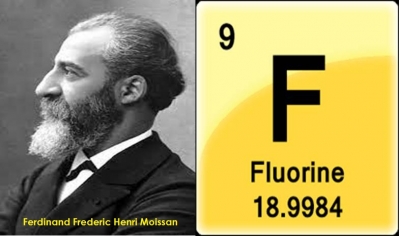
Fluorine is the most reactive element on the Periodic Table, and it has a violent history in its quest for discovery. Being a vital element for humans and animals, despite its difficult and explosive properties, fluorine is commonly found in drinking water and toothpaste. It is fluorine that helps prevent tooth decay!
Fluorine is the most reactive of all elements. No chemical substance can detach fluorine from any of its compounds. As a result, fluorine does not exist freely in nature and it was extremely difficult for scientists to isolate it. In 1869, George Gore was able to produce a small amount of fluorine through an electrolytic process. But Gore didn’t know that fluorine gas explosively combines with hydrogen gas and in his experiment, the fluorine gas that formed on one electrode combined with the hydrogen gas that formed on the other electrode and exploded. In 1886, a French Chemist named Ferdinand Frederic Henri Moissan was the first to successfully isolate fluorine. His work earned him the Nobel Prize for chemistry in 1906.
According to the Royal Society, fluorine is a vital element in the nuclear energy industry. A small amount of fluorine is essential for maintaining the strength of our bones and teeth, and an excess of it will have the reverse effect of causing osteoporosis or tooth decay. Excess fluorine can also harm the kidneys, nerves, and muscles.
Picture Credit : Google




